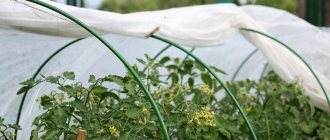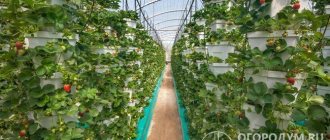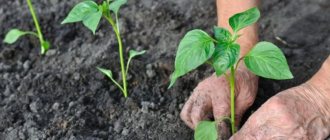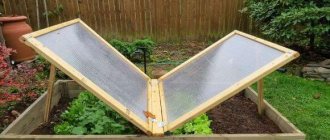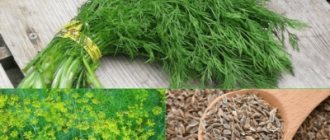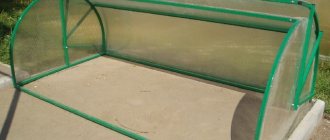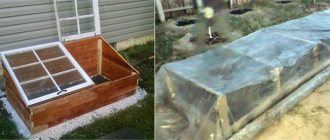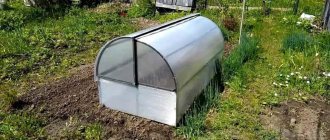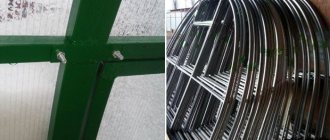272
Each vegetable crop requires certain conditions for full growth processes to occur, and therefore, a greenhouse for peppers is often built to create all the required conditions. It is very often used to create optimal growing conditions.
Today, greenhouse designs differ in the variety of bases and materials used. Pepper is considered a heat-loving and light-loving plant, so seedlings are grown in structures that provide optimal conditions required by the crop. In this work, we will consider diagrams of the main designs of greenhouses for pepper.
Our country is distinguished by its enormous scale and diversity of climatic features. Each region has a range of different conditions, and in some places pepper does not grow in open ground and the main growing area is in a greenhouse. And in some regions it is used only for growing pepper seedlings. Therefore, during its construction, you need to clearly understand the purpose of such a structure.
DIY greenhouse
A small greenhouse that opens as much as possible in warm weather for peppers is the best way to grow them. Large greenhouses are less successful for this vegetable, since pepper is a light-loving crop, and in a greenhouse the access to light is still somewhat limited.
In addition, the number of bushes planted is most often not very large, which means that pepper will have to be planted in the greenhouse together with other crops, and this is not desirable, because this crop requires the creation of special climatic conditions.
All this suggests that it is better to make a small greenhouse for peppers, using materials that are inexpensive and accessible to any vegetable grower. Making a greenhouse for peppers with your own hands is quite simple and we offer you several simple options with photos: 1. A greenhouse on a foundation.
For such a structure, a number of bricks are laid along the perimeter at a selected location, held together with a cement mixture. The greenhouse should be built in the most open place possible to allow sunlight to reach the plants. The orientation of the greenhouse is chosen to be east-west, and the structure should open from the south.
To build the walls of the greenhouse, you can use timber or old boards. A kind of rectangular box is built from this material on the foundation. The top of the structure is covered with an old frame or a frame made of slats covered with film. To make it more convenient to open or open the greenhouse, the roof should be secured with hinges.
The roof of the greenhouse is made of a pitched or gable roof. When constructing a pitched roof, one edge of the box is made 20-25 centimeters higher. The height of the box should not exceed 40-50 centimeters, otherwise the plants will lack light.
2. Tunnel arc-shaped greenhouse.
This type of structure is portable. It is made from metal wire or polypropylene pipes, bent into an arc and stuck into the ground or mounted on a wooden frame. The distance between the arcs is 50-60 centimeters. The width is calculated so that a maximum of four rows of peppers fit inside.
The frame is covered on top with plastic film or covering material of medium or high density. The bottom coating is fixed with any heavy objects. You can nail slats along the edge, which, when opened, will roll up the covering material. The arcs can be fixed together with wire or wooden slats, this will increase the strength of the structure.
3. Greenhouse based on a frame.
This type of pepper shelter is a construction made from slatted frames covered with film. The frames are fixed to a base made of timber or boards. You can make the structure in the form of a house or in the form of a rectangular box covered with a frame on top.
Instead of film, you can use polycarbonate sheets. In this case, the strength and durability of the greenhouse will increase significantly, although its cost will also increase.
You can see other greenhouses that you can also assemble or make with your own hands here: From arcs, From polycarbonate, From window frames, For seedlings, From a profile pipe, From plastic bottles, For cucumbers, Under film, For the dacha, From PVC, Winter greenhouse , Beautiful cottage, Successful harvest, Snowdrop, Snail, Dayas
List of required materials
As before starting any construction, you need to analyze all your capabilities; today, in stores there are a large number of offers for assembling ready-made greenhouse structures, which are quite simple to assemble and install.
But such proposals are considered quite expensive and the only advantage is saving time, which is sometimes priceless.
In cases where you are thinking about building for one season, then using old windows is quite acceptable. But, if you still decide to build a high-quality greenhouse yourself, then you need to stock up on some materials.
In order to figure out what you want to see on the site, you need to understand what types are needed specifically for pepper:
- Greenhouse for pepper made of polycarbonate.
- Glass.
- Film.
Most often, the base is constructed from wood, less often from metal pipes or corners.
Important! One-season structures can be constructed from wire and metal pipe scraps. Corners, etc., that is, from scrap materials.
The use of old windows is considered an economical option for constructing a greenhouse structure, but also ensures the conservation of heat and light. Namely, these factors are fundamental for the germination of peppers.
Variety selection
Not all varieties of pepper are suitable for growing in a greenhouse or greenhouse. For cultivation in closed ground conditions, you should choose low- and medium-sized varieties. The most popular pepper varieties for greenhouses are:
- Negotiant.
- Pinocchio.
- Tibul.
- Centurion.
- Master.
- Barguzin.
- Bagration.
- Chord.
- Cornet.
All these varieties are resistant to the most common pepper disease - blossom end rot. They quickly begin to bear fruit and manage to ripen on bushes in unheated greenhouses and greenhouses.
Advantages and disadvantages
As mentioned earlier, modern greenhouses made of corrugated pipe are a common phenomenon. People turn to the construction of such buildings because they have many positive qualities. Let's get acquainted with the most important of them.
- Buildings made from profile pipes, made according to all the rules, can last a very long time, without causing unnecessary trouble to the owners.
- It is permissible to complete frames made of corrugated pipe with various covering materials. It can be either glass or polycarbonate, or a special film - the choice is up to the owners.
- Greenhouses made from corrugated pipe can boast simple, but at the same time quite reliable fastenings.
- Assembling such structures does not take up any extra effort or a lot of free time, so many owners take on the challenge of making them themselves.
- It is quite possible to build a greenhouse of any shape from a profile pipe.
- A well-constructed outbuilding will not be afraid of negative external factors, such as strong winds. In a high-quality greenhouse made from corrugated pipe, nothing will threaten the plantings.
- A wisely made greenhouse made of pipes can not only perform its main functions, but also become a real decoration of the site. For example, beautiful options with glass coatings boast a spectacular appearance. In them you can grow not only vegetables, but also a variety of flowers. Multi-colored flower arrangements will look unsurpassed behind the glass walls of such a structure.
From all that has been said, we can conclude that greenhouses made from profile pipes are very stable and practical. That is why they occur so often. However, we must not forget about some of the shortcomings that they suffer from. Let's get acquainted with them.
When making a greenhouse from corrugated pipe, many craftsmen are faced with a serious problem - direct bending of the material
Here it is very important to bend the first pipe correctly in order to use it as a template in the future. This part is pre-filled with sand for a smoother and more aesthetically pleasing bend.
Which covering material is better?
It is very important to choose a good covering material that will allow the crops to receive enough light, but will not be too expensive
Spunbond
This is a rolled and very thin material, which in most cases is very convenient to use for a greenhouse. It is very easy to install, and is also very inexpensive per square meter.
Polycarbonate
This is one of the most popular materials for greenhouses. Its advantages are that it is relatively durable. It has excellent thermal insulation and light transmittance. Despite the ease of installation, this is a fairly durable material that will last for many years. Another advantage of polycarbonate is its aesthetic appearance. A greenhouse made of this material will look great on any site. The main disadvantage of polycarbonate is its relative high cost. But given the small size of the greenhouse for peppers, it can be called a good choice.
PVC film
The film is also quite often used by summer residents and gardeners. It became widespread because of its low cost. Anyone can fix this material.
This is a very short-lived material that often deteriorates and breaks.
But a regular greenhouse for peppers does not require year-round maintenance, so it will be convenient to update this material every spring. Therefore, if you are ready for this, then choose film.
Glass
A glass greenhouse is a good solution, especially if you have glass. But they have quite a few disadvantages - the material is fragile, difficult to install, and requires maintenance.
Agrofibre
This is an incredibly light and inexpensive material, which is often more profitable to use than analogues. This is such a light material that it can be laid directly on the bushes, even without a frame.
This is a huge plus of agrofibre. Keep this in mind if you do not want to build a massive frame.
Reinforced fabric
This is an excellent material that is similar to regular plastic film, but much stronger. It consists of 3 layers that form a single fabric.
Preparing seedlings
Pepper is a crop that has the longest growing season, so it is sown earlier than all crops grown by seedlings. Recommended sowing time is the end of February.
The root system of pepper is very fragile, so it does not like frequent replanting. Experienced gardeners recommend sowing peppers in separate containers.
Cups without a bottom are placed in a box or on a pallet and filled with a mixture of soil and sand or peat (2:1). You can use a ready-made soil mixture for peppers from the store.
The seeds are pre-treated with a solution of potassium permanganate, then with a growth stimulator.
Containers with crops are covered with transparent material and placed in a warm and bright place. When the peppers grow to 15-20 cm, they should be pinched . This technique stimulates the growth of side shoots to form a lush bush. A large number of shoots will increase the number of fruits on one bush.
It is recommended to feed the seedlings several times. The first feeding is carried out in the phase of three leaves, the second - 4-5 leaves. The pepper should receive the largest amount of fertilizer when the bush forms 8-9 leaves, since from this time the formation of flower buds begins.
An important stage in growing seedlings is hardening. Containers with sprouts are taken out to the balcony during the day; at night they must be moved to a warm place. The pepper also needs to be acclimated to sunlight, from time to time placing it outside in a shady place. Peppers that are not prepared in this way will begin to hurt when planted in a greenhouse, as it will be difficult for them to get used to the sudden change in microclimate.
ADVICE! Treatment of plants with Epin, which increases plant immunity, will help increase the resistance of plants.
Dimensions
The size of the greenhouse is an individual matter.
Some people, even with the help of a mini-type structure, are able to provide themselves with fresh vegetables for the whole summer, growing them on a square meter, but for some, even a 3 by 6 area will not seem enough. Some people are used to a 4 x 8 meter greenhouse and have been getting a stable harvest from it for years. A small greenhouse will find its place in a garden with limited space. Narrow, sometimes very low structures are also appropriate here.
The size of the building may also depend on how the plants are located under its roof. You need to understand what width of tracks is convenient for processing in a particular case, how many of them are needed in total. This will help you decide what area and configuration of the greenhouse will suit a particular user.
When determining the area of a polycarbonate structure, you must also keep in mind that a standard sheet of material is 2.1 by 6 meters. It is no coincidence that greenhouses 2 m wide can be found quite often. Given that the material is cut, it is easy to erect buildings of different sizes - from small to very impressive. It can be approximately 6x3, and 2x3, and 2x4, and 3x4, and 2x6 m.
The height of the greenhouse is usually about one and a half meters or less.
Planting correctly
When 12-13 true leaves it is time to plant the plants in a greenhouse . During this period, buds begin to form on the peppers, the root system is fully formed and ready for growing in a greenhouse.
To avoid unnecessary stress on plants during transplantation, it is advisable to take the boxes with plants into a greenhouse a week before planting . They must be closed at night, and during the day, depending on the air temperature, they are opened partially or completely.
Planting in a greenhouse can be done when the ground warms up to 15-16 degrees. In unheated greenhouses this happens no earlier than mid-May.
Before planting, the soil in the greenhouse is specially prepared. Compost or humus and phosphorus-potassium fertilizers are added.
IMPORTANT! Do not apply fresh manure under the pepper, this will cause the ovaries to fall off and there will be no fruit on the pepper.
For planting peppers
the optimal width is within 1 meter, the row spacing is 50 cm. Low-growing varieties are planted at a distance of 20 cm from each other, medium-growing ones - 25-30 cm, high ones - 35-40 cm. Plants are planted in holes well-drained with warm water .
You can see how to properly and quickly plant pepper seedlings in a greenhouse in this video:
ATTENTION! Do not bury the pepper stems above the level at which they were in the cups. After planting, the soil should be crushed, watered and mulched.
Home mini greenhouse
It only takes 30 minutes to assemble this mini greenhouse with your own hands.
True, this is a kit from Ikea that you can buy in a store, but it can also be completely DIY from glass and wooden slats. Look at the step-by-step photos, what's so complicated about that?
Photo source: www.runtoradiance.com/diy-gold-ikea-hack-greenhouse/
Greenhouse in a light bulb
The incandescent lamp is the main symbol of wasted energy. But if you have a burnt out light bulb, don't rush to throw it away. It looks amazing, but you can actually make a mini greenhouse in a light bulb. To do this you will need:
- old light bulb;
- epoxy adhesive;
- a piece of rubber;
- mixer cup (reflector);
- small plastic cup
- the soil
Prepare the light bulb
- Using pliers, remove the bottom contact.
- Then break the glass between the two contacts and on the inside, align the edges.
- Clean the white powder from the light bulb. You can do this with a rag, water or a compressor (not recommended).
- It is necessary to widen the hole in the lower part of the socket; you can use a drill.
- Then use pliers to widen the hole at the bottom of the light bulb.
- Glue the rubber to the base with epoxy glue. Let dry for at least twenty minutes.
- Plant the plant or seeds, this step is probably self explanatory.
- Now place it on the base and put on the light bulb.
Place on a well-lit windowsill and water occasionally.
Photo source: www.instructables.com/id/Lightbulb-greenhouse/
Indoor mini greenhouse
This very simple miniature indoor greenhouse resembles a country house. A frame of small sticks is wrapped in something like cellophane. You can even experiment by adding multiple shelves to create more space inside a tiny space.
This project is simple, easy and fun that can be done in a couple of hours. Not only is it fun and cool, but it also provides a warm and cozy home for the seedlings!
Photo source: www.instructables.com/id/Mini-Greenhouse-2/
Home mini greenhouse for seedlings
F6 Another option for a small home greenhouse that you can use for seedlings. You will need to purchase several wooden sticks, tape, plastic wrap and allocate approximately 20 minutes of free time. In the end, you will get a cube-shaped greenhouse house that can be installed inside a wooden box. First, make two U-shaped frames, the bottom part should be approximately the width of the box, and the height should be a few centimeters higher than the greenhouse. Then you need to cut two sticks, slightly smaller in size than the greenhouse box.
After this, attach the sticks to the plastic film, try to make the corners as straight as possible. Leave a couple of centimeters in reserve at the bottom of your legs. Cut the film from each corner in the direction of the joint between the U-shaped and long handle. Fasten the tape to create a 90-degree angle between the long stick and the U-shaped legs. The mini greenhouse is ready, you can sow.
Photo source: www.instructables.com/id/Mini-greenhouse-3/
Small LED greenhouse for growing plants
Here's another idea on how to make a mini-greenhouse in a cardboard box to grow seedlings at home. For this project you will need: a cardboard box, LED strip and aluminum foil. The author of the project decided to apply aluminum foil to the box because it is highly reflective and can serve as a water barrier. You need to cover all corners so that water, if it gets into the box, does not ruin your greenhouse. Use spray adhesive, it is easy to apply and works great. To allow light to enter the middle of the box, cut a hole as shown in the photo.
Since the light covers almost the entire top of the box, cut a hole around the entire top except the flap side and corners to maintain strength. Plant several seedlings in a small tray and then place in small pots. Use the flap as a lift to bring plants closer to the light before they mature. To keep plants growing strong, use a hydroponic fertilizer. This is essentially the same as a hydroponic setup, but using a sterile growing medium that looks like soil. Water on a daily schedule.
Photo source: www.instructables.com/id/Indoor-LED-Plant-Grow-Room/c
All about growing peppers in a greenhouse
High temperature and humidity are the main conditions for successfully growing peppers.
That is why growing it in film shelters is most acceptable, since such conditions can be created in them.
To achieve success you must do the following:
- Water the plants correctly. Watering should be plentiful, always with warm water. The soil under the pepper must not be allowed to dry out, let alone crack.
- Ventilate in time. In hot weather, the greenhouse should be opened as much as possible, since peppers cannot tolerate too high temperatures.
- Form bushes. For better lighting of the bushes, the pepper must be trimmed, leaving 2-3 of the strongest stems. But there are varieties (Barguzin, Buratino) that do not need pruning. In addition to formative pruning, it is necessary to remove the lowest flower bud, as well as all shoots that do not have flowers.
- Feed regularly. About once a month, watering should be combined with fertilizing with organic or mineral fertilizer. But organic fertilizers can be applied only once during the entire period and in low concentration. An excess of nitrogen will lead to an increase in leaf mass, and fruits will not set.
- Shade from the sun. Pepper is a sun lover, but not hot or scorching, so on especially hot days it should be shaded. Otherwise, its leaves will turn white and the flowers may fall off.
- Treat against pests. Treatment with insecticides (Karbofos, Actellik, etc.) can help prevent the appearance of harmful insects. Eliminate ants in greenhouses in a timely manner, because they are carriers of aphids, a dangerous pest for peppers.
- Protect from diseases. It is necessary to carefully monitor changes that begin in plants. If you notice any spots on the leaves or fruits, curling of the leaves, or lethargy of the bush, it means that the pepper has become infected with some kind of disease. First of all, treat the bushes with Fitosporin and feed them. Severely affected specimens should be removed immediately.
- Protect from wind and drafts. Particularly dangerous is the opening of two ends in tunnel coverings. With such ventilation, the pepper ends up in a draft, and this harms it.
- Loosen the soil. The roots need access to air, so loosening should be done after each watering. Just do not loosen the soil deeper than 5 cm - there is a risk of damaging the delicate roots.
Secrets of a rich harvest
When growing peppers, it is worth considering some features of this crop in order to get the desired result:
- Never water peppers from above, as this is a self-pollinating crop and in this way you wash away the pollen, which means you reduce the number of ovaries;
- During active flowering, shake the bushes with a stick to enhance the fall and setting of flowers;
- Do not plant bitter and sweet varieties next to each other. The bushes are capable of cross-pollinating, and all your peppers will be bitter as a result.
In early August, pinch the tops of the bushes and remove all buds that have not formed ovaries.
This technique will allow the bushes to grow already formed fruits, since new ones will not have time to grow during this time.
Following all these rules for caring for peppers in a greenhouse will allow you to enjoy tasty and healthy fruits grown with your own hands on your own plot.
Why choose polycarbonate coating?
The frame for greenhouses for peppers can be found in two versions. The first is wooden, which, naturally, is not so durable, but much cheaper. The tree should definitely be treated with an antiseptic to increase its service life. A wooden frame will last you for several seasons.
The second one is metal. It is much more expensive, but its durability increases tenfold. This frame for growing peppers can have different configurations: from a square to a circle. Metal also requires maintenance. If you don’t want to see rust on the frame over time, treat it with paint or primer.
